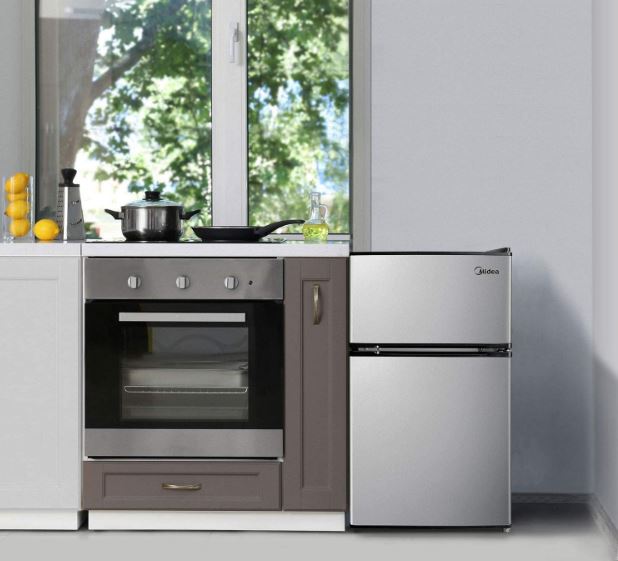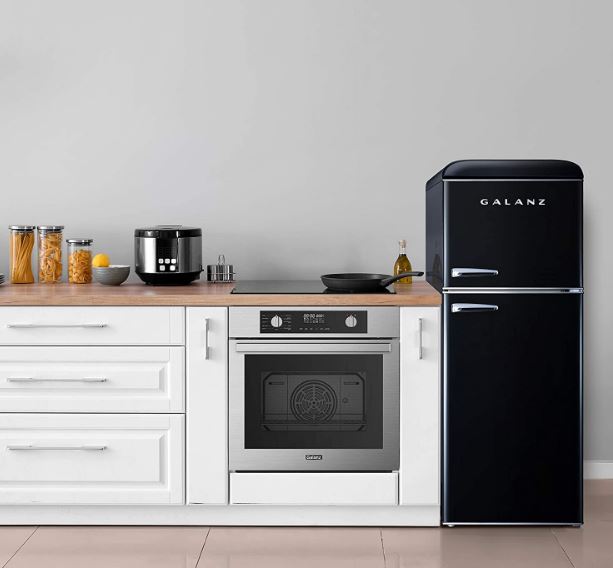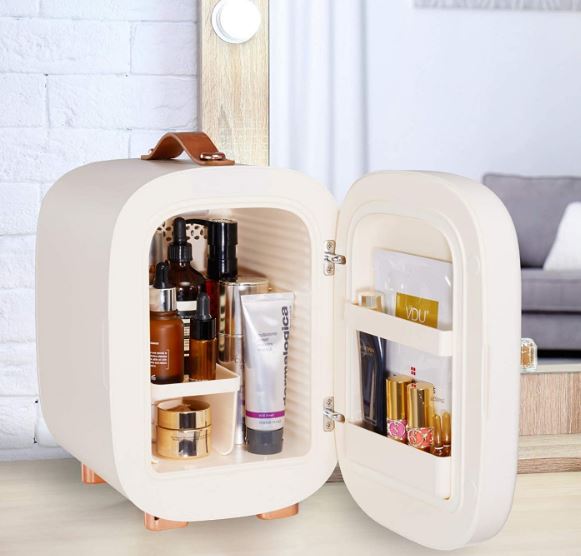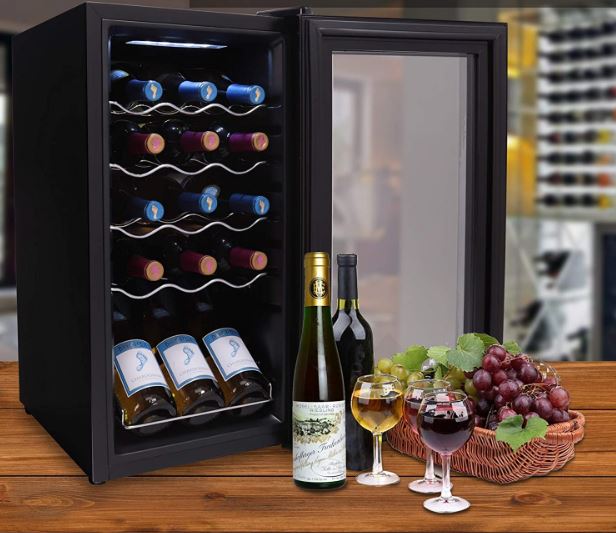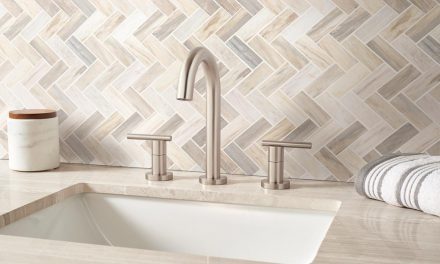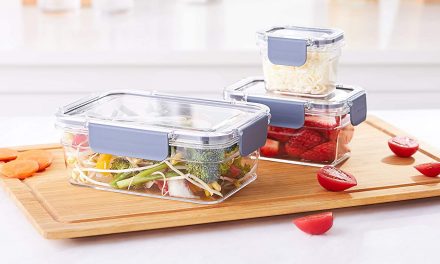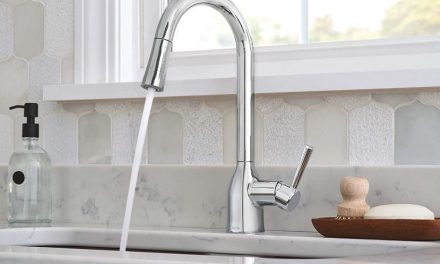Have a small apartment, office space, or rumpus room that needs a fridge? Mini fridges are a great way to make chilled foods and beverages accessible wherever you may need them, but not all mini fridges are a good deal. In this article we’ll help you unpack the main differences between mini fridge sizes and their uses, as well as how different cooling technologies can impact your experience.
Types of mini fridges by size and use
Unfortunately “mini fridge” has no official definition, but there are some common characteristics most of these fridges exhibit.
Generally speaking, you’ll see the most variability in height, with the majority of mini fridges never exceeding 45 inches (114 cm). They’re also narrow in width. Nearly all mini fridges are no more than a couple of feet wide (<61 cm).
There is a considerable range of capacity options. Some sellers will market a fridge as “mini” only if the fridge has between 1.5 and 4.5 cubic feet of storage (11-34 gallons / 42-127 liters), but the truth is you can find mini fridges that have smaller or much higher storage capacity. Manufacturers in particular recognize much larger fridges as “mini,” simply because they are smaller than traditional fridges.
So, it’s a little confusing, but the good news is there really is something for every need.
Mini fridges that fit beneath counters and are good in dorms
Most kitchen counters and desks stand about three feet tall (91 cm), so if you’re wanting to install or replace a mini fridge for a kitchen, kitchenette, or office space, this is probably the size you need to be looking for. This is also the ideal size for most cramped college dorms.
At this size, mini fridges tend to be single-door appliances and have about a 50/50 chance of containing freezer capabilities and having dial temperature controls. Most have roughly 2-5 cubic feet (15-37 gallons /, 57-142 liters) of storage space.
If this is a fridge you’re wanting to last, look for one that uses a compressor for cooling. Thermoelectric cooling will likely not get as cold as you want in a fridge this size, and it will not support a good freezer.
Pros:
- Fits under standard countertops and some desks
- Good for dorms, kitchenettes, office spaces
Cons:
- Single-door; unlikely to have dedicated freezer storage
- Freezers only found in more expensive models
- May or may not have temperature controls
Price range: $100-$250
Midsize mini fridges with good freezers
While it’s possible to find under-the-counter mini fridges that have a freezer, most are single-door appliances. Every time you open the fridge door, you’re also opening onto the freezer, thereby losing cooling and interfering with efficiency. If you’re looking for a mini fridge with better freezing capabilities, stick with two-door designs that have a dedicated freezer compartment.
Most mini fridges that have a top-door freezer are midsized, meaning they’ll be taller than your standard counter height. On the upside, this also means they have more storage space. At their largest (8-12 cubic feet / 60-90 gallons / 227-340 liters), these mini fridges are more like narrow standard or full-size fridges, and you’ll often see them marketed as “retro” fridges for this reason.
Because thermoelectric cooling can’t keep freezers cold enough in most cases, these midsized mini fridges with their dedicated freezers will use compressor or absorption cooling technologies. Expect them to cost more because of this, but they’ll also last longer, so long as you move them carefully.
Pros:
- Basically a mini or narrow traditional fridge and freezer
- More or better storage options
- Because they’re larger, more likely to have more shelving options
Cons:
- More expensive
- Not as portable
Price range: $150-$500
Cube mini fridges for skincare or portable needs
The smallest of the mini fridges, most of which only hold 4 liters of goods—basically six cans of soda—have niche uses. They’re perfect for road trips and beloved by the skincare and beauty market, where some people swear by keeping certain products refrigerated. As such, fridge manufacturers tend to design and market these miniest of the mini fridges to travelers and/or the beauty market. They’re sometimes called “cube” mini fridges, due to their common cube or cube-like shape. They do not have a freezer.
Made to fit in small spaces, especially car seats or on bathroom countertops, these fridges are also portable. Some sport convenient carrier handles and special compartments for beverages or skincare items. As typically simple thermoelectric fridges, with basic on/off functionality, many can be charged via the 12V cigarette lighter ports found in cars. A few claim they can be charged via USB.
In the case of skincare, you may be wondering, Are these fridges worth it? The answer is a solid maybe! Super helpful, right?
Marketers and some skincare/beauty gurus claim that keeping lotions, makeups, and application tools chilled has several benefits. The most common claims are that some beauty products actually apply to the skin better when cool and that the chilled environment helps prevent or slow the growth of bacteria and fungus, thereby extending product shelf life. And it is true that cooling can help reduce puffiness, especially around the eyes.
Dermatologists and other skincare professionals who’ve weighed in on the matter have given mixed opinions on the effectiveness of these fridges.
Bottom line? There may be some benefits to keeping some skincare/beauty products cool, but if you don’t need the portability of a skincare fridge and don’t have the space or money for one in your bathroom, don’t sweat it. Just pop your beauty items in your regular fridge or a larger mini fridge that won’t take up space where you don’t have it.
Pros:
- Portable
- Multiple charging options
- May extend the shelf life of skincare/beauty products
- Very compact, can be good option for those on the road or with enough counter space
Cons:
- No freezer
- Still requires space; not good for small bathrooms
- At the same time, can be too small to store many items
- Lacks temperature controls
- No strong research to support marketers’ biggest claims for skincare
Price range: $40-$150
Freestanding wine cellars
Freestanding wine cellars are refrigerators designed specifically for wine bottles. They generally have racks instead of shelves that usually store bottles bottom first for easy retrieval. They range in size from small models that hold only a few bottles to large-capacity versions that can hold more than a hundred.
Smaller versions are either fully freestanding or can be inset under counters. They can be lit, though not all have lights, and most are clear-fronted, allowing the contents to be displayed; unfortunately, this also makes them less portable.
Wine bottle coolers are often designed for their looks and don’t need especially good cooling technology. Most are thermoelectrically cooled and won’t come with a freezer, since low noise and vibration are more important in this setting. It will only be in larger models that you may see more powerful compression or absorption cooling.
There are two main types of freestanding wine cellar—single zone and dual zone. Which one is best for you depends on what you want to do with your wine bottle cooler.
The ideal temperature to store all wine is between 50°F and 60°F (between 10°C and 15°C), but there are differences for serving. White wine is generally served cooler, around 50°F (10°C), while red wine is served warmer, around 60-68°F (15-20°C). Rosés are generally served somewhere between those temperatures. Sparkling wine can be served at around 40°F (5°C) depending on taste.
For storage, then, a single zone wine bottle cooler is all you need, but if you’d also like to be able to bring your wine to the appropriate temperature before serving, dual zone might be for you.
Pros:
- Perfect for wine storage and serving
- Often aesthetically pleasing
- Can have very specific temperature controls
Cons:
- Not very versatile, and racks aren’t designed to hold anything other than bottles
- Not portable
- No freezer
- Narrow temperature range
Price range: $100-$1500, though larger commercial models can cost upwards of $5000
Types of mini fridge cooling technologies
While mini fridges may often look quite similar, their cooling technologies vary and this determines just how good your fridge will be at keeping your drinks, food, or other items.
Mini fridges with compressors
Full-size refrigerators use a compressor to keep contents chilled or frozen, so mini fridges that make use of compressor technologies offer the most similar experiences to a standard full-size fridge.
In these fridges, a liquid refrigerant passes through an expansion device (a valve or tube), which decreases the pressure of the liquid refrigerant, causing it to cool, expand, and transform into a gas. This refrigerant gas then travels through an evaporating (think dehumidifying) coil system in the back of the fridge, cooling the inside of the appliance and its contents until it reaches a compressor.
Compressors control the pressure of gasses. Fridge compressors increase the pressure on refrigerant gas, heating it up. This hot gas then radiates heat out the back of the refrigerator. As the gas travels back up the coil system, it cools once more, turning into a liquid once more which then travels back through the expansion device to begin the cycle again.
Typically found in: Midsize to large mini fridges that have 3+ cubic feet of storage capacity
Pros:
- Closest experience to a traditional fridge
- More accurate and more likely to have temperature controls
Cons:
- Can be on the larger side of “mini” fridges
- More expensive to run, usually to support the demands of a freezer
- Heavier due to coil system
Price range: More expensive; usually at least $150+
Thermoelectric mini fridges
The smallest of mini fridges, many of which are portable, tend to use thermoelectric technology for cooling. Thermoelectric coolers have two different metals sandwiched together, surrounded by an insulator, usually ceramic. When you run electricity through the cooler, one side gets cold and the other side gets hot. The cold side keeps the fridge cool, and the hot side is cooled down with an air pump.
These fridges are usually affordable and generally less bulky than compression fridges. They also tend to be quieter than compression fridges, and since there’s no coolant, there’s no need to handle them especially carefully. However, they’re less efficient and may struggle to reach lower temperatures, especially in warmer environments. This kind of cooling works better for smaller, portable fridges and wine coolers, and they’re not great for long term use.
Typically found in: Very small, portable fridges, especially cheap ones
Pros:
- Affordable
- Lightweight
- Durable, with fewer moving parts than compression fridges
- Quieter than compression coolers
Cons:
- Heats up the area around it
- Doesn’t work as well in hotter environments (+80°F/25°C)
- Less efficient and uses more electricity
- Less accurate, less likely to have temperature controls
- Seen in cheaper fridge models and often not built to last
Price range: Cheap; often under $100
Absorption mini fridges
A high quality (and often high price) option, absorption mini fridges are great, reliable appliances. Though, they aren’t as common as the other kinds of mini fridges, and there may not be many options available.
Absorption coolers work similarly to compression coolers. A liquid refrigerant (usually ammonia) evaporates in a low-pressure environment, cooling the inside of the appliance and its contents. Unlike compression coolers, though, absorption coolers have a second liquid refrigerant that absorbs the first out of the air. This allows absorption fridges to be built with no (or few) moving parts, making them extremely durable. This also allows a wider variety of heat sources to be used (like propane) making these fridges popular for off-the-grid living.
Typically found in: RV and camper fridges; anywhere that doesn’t have reliable electricity
Pros:
- Quietest fridge option
- Few moving parts
- Uses very little power
- Can often be powered by a variety of heat sources, including propane
Cons:
- Pricier than other styles
- Expensive to use and maintain
- Less portable; must be kept upright when moving
- Don’t cool as quickly as compression fridges
Price range: Most expensive; often $200+
What to look for in a mini fridge
Outside of size and technological differences, mini fridges also have a handful of features that set them apart from each other and may make or break a purchasing decision. As you hunt for your ideal mini fridge, be on the lookout for these features.
- Cooling technology. As mentioned above, depending on what you’re wanting to use your fridge for, the cooling technology may matter a lot. Basically, if you’re looking for a good fridge to replace something larger, you probably want to stick with compressor-based cooling.
- Temperature controls. With the smallest mini fridges, what you see is what you get. They have few, if any, additional features. One of the few exceptions to this is dial temperature controls. Mini fridges have about a 50/50 chance of having them.
- Visibility. Seeing what’s inside your fridge is useful. Not all mini fridges come with glass doors, but that’s probably not a deal-breaker unless you’re wanting something sleek for an entertainment room. More important is that many mini fridges don’t necessarily come with automatic door lights, either.
- Shelving. If you’re wanting a mini fridge to replace something larger, you’ll want good shelving.
Energy Star ratings

The Energy Star guide for Black+Decker’s cube fridge.
While mini fridges often use less energy than full-size fridges, this largely has to do with their size and, in some cases, their lack of a freezer compartment. They may or may not be as energy efficient as larger fridges per cubic foot. If energy efficiency is of great concern to you, look for Energy Star rated appliances. Online, you’ll find an energy guide listed somewhere on the individual product’s sale page.
- Shop compact refrigerators with an Energy Star rating
- Search for compact fridges on Energy Star’s database
Mini fridges made in the USA
- GE (General Electric) was formed in 1892 as a merger between the Edison and Thomson-Houston electric companies. Today, they manufacture a wide variety of consumer products as well as goods in the aviation, healthcare, and power sectors. Not all of their refrigerators are primarily manufactured or assembled in the US, so make sure to check the individual model for the details.
- Marvel Refrigeration was founded as Ranney Refrigeration in 1892 and produces a variety of freestanding and undercounter mini refrigerators, freezers, and ice makers. All Marvel products are manufactured in their factory in Greenville, Michigan.
- Perlick has been family-owned since 1917 and is based in Milwaukee, Wisconsin. They manufacture a variety of under-the-counter refrigerators and wine bottle coolers.
- Subzero, also sold under the brand name Wolf, is a US-based appliance company that specializes in high-end undercounter refrigerators and wine bottle coolers. Founded in 1945, Subzero manufactures their appliances in factories in Wisconsin and Arizona.
- U-Line is a high-end manufacturer of mini refrigerators, freezers, ice makers, wine bottle coolers, and more. Founded in 1962, U-Line continues to manufacture and assemble their products in their factory in Milwaukee, Wisconsin.
- Whirlpool got their start in 1911 in Benton Harbor, Michigan, building wringer-washers. Today, Whirlpool is a multinational company that produces a wide variety of consumer appliances. They also sell mini fridges under the Maytag brand after acquiring it in 2006. Not all Whirlpool and Maytag appliances are manufactured in the US, though, so make sure to check out the brand details to be sure.
Mini fridge starter kit
Don’t want to waste time on research yourself? Let’s cut to the chase about best buys:
- Looking for a small fridge for your dorm or office space? At the very smallest end, you should consider Black+Decker’s single-door mini fridge. Unlike most mini fridges at this tiny, cube-like size and price point, it’s actually compressor-cooled, has temperature controls, and even has an ice tray. If you need something a little larger, look to Midea’s two-door, compressor-cooled mini fridge and freezer, which holds a lot and has nice features for a fridge that’s only as tall as your average countertop.
- Wanting to replace a traditional fridge with something slightly smaller? Consider a Galanz retro fridge. These compressor-cooled fridges are rated highly by consumers, and their adorable retro design makes them a fun centerpiece in any small kitchen.
- On the road and looking to keep drinks and snacks cool? Get a portable fridge, like Crownful’s 4-liter portable cooler. These simple, thermoelectric fridges are nothing fancy, but they’ll get the job done and survive getting knocked around a little. If you’ve got a little more to spend or are on the road a lot, consider a larger, compressor-cooled solution, like AstroAI’s portable cooler.
- Wanting to test all the skincare benefit claims? Get a Qubi mini fridge. There are similar skincare fridges at slightly lower price points, but Qubi is designed with skincare products in mind. As a bonus, it looks like an old school makeup case.
- If you’re looking for additional space-saving storage options in your home, get a mini fridge stand. If you think you might move it in your home or relocate, look for a stand with wheels to make life easier.


